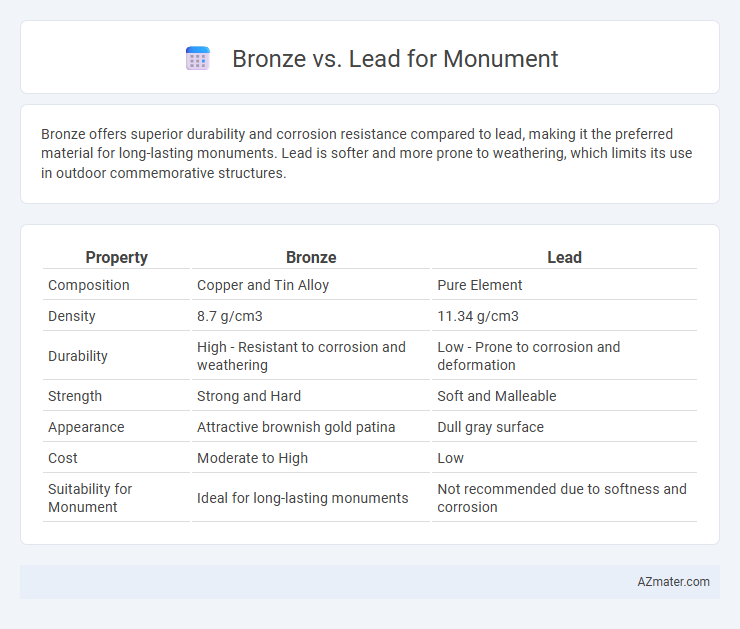Bronze offers superior durability and corrosion resistance compared to lead, making it the preferred material for long-lasting monuments. Lead is softer and more prone to weathering, which limits its use in outdoor commemorative structures.
Table of Comparison
| Property | Bronze | Lead |
|---|---|---|
| Composition | Copper and Tin Alloy | Pure Element |
| Density | 8.7 g/cm3 | 11.34 g/cm3 |
| Durability | High - Resistant to corrosion and weathering | Low - Prone to corrosion and deformation |
| Strength | Strong and Hard | Soft and Malleable |
| Appearance | Attractive brownish gold patina | Dull gray surface |
| Cost | Moderate to High | Low |
| Suitability for Monument | Ideal for long-lasting monuments | Not recommended due to softness and corrosion |
Introduction: Comparing Bronze and Lead for Monuments
Bronze and lead are both traditional materials used in monument construction, each offering distinct properties and aesthetic qualities. Bronze is valued for its durability, corrosion resistance, and ability to capture fine details, making it ideal for long-lasting statues and plaques. Lead, while easier to mold and cost-effective, is softer and more prone to weathering, often requiring additional treatments to ensure longevity in outdoor monuments.
Historical Use of Bronze and Lead in Monuments
Bronze has historically been favored for monuments due to its durability, resistance to corrosion, and ability to capture fine details in sculptures, making it ideal for statues and plaques since ancient civilizations like the Greeks and Romans. Lead, while easier to mold and abundant, was primarily used for inscriptions, smaller commemorative plaques, or as a core material in larger monuments rather than standalone sculptures because of its softness and susceptibility to weathering. The longevity and aesthetic qualities of bronze have established it as the preferred choice for enduring monumental art, while lead served functional roles in monument construction and detail work throughout history.
Material Properties: Bronze vs Lead
Bronze offers superior durability and corrosion resistance compared to lead, making it ideal for long-lasting monuments exposed to outdoor elements. Its higher tensile strength and hardness provide better structural integrity and detail retention over time, while lead's softness and susceptibility to oxidation limit its use in outdoor monuments. Bronze also develops a protective patina that enhances aesthetic appeal and surface protection, whereas lead may degrade and lose detail more rapidly.
Durability and Longevity
Bronze exhibits superior durability and longevity compared to lead, as it is highly resistant to corrosion, weathering, and environmental wear, ensuring monuments remain intact for centuries. Lead, while malleable and easy to cast, suffers from significant oxidation and structural degradation over time, reducing its lifespan and compromising monument integrity. Bronze's robust composition and resistance to elements make it the preferred material for long-lasting monumental sculptures and plaques.
Resistance to Weathering and Corrosion
Bronze exhibits superior resistance to weathering and corrosion compared to lead, making it a preferred choice for outdoor monuments exposed to varying climatic conditions. Its copper-tin alloy composition forms a protective patina that shields the structure from oxidation and environmental damage over time. Lead, being softer and more prone to oxidation, deteriorates faster when subjected to moisture and pollutants, resulting in reduced longevity and increased maintenance.
Aesthetic Appeal and Surface Finish
Bronze offers a warm, rich patina that deepens over time, enhancing the monument's aesthetic appeal with a classic, timeless look. Lead provides a matte, smooth surface finish that resists corrosion but lacks the intricate texture and vibrant color variation found in bronze. The choice between bronze and lead significantly impacts the monument's visual character and long-term surface quality.
Safety and Environmental Impact
Bronze offers superior safety in monuments due to its corrosion resistance, preventing harmful metal leaching compared to lead, which poses significant health risks from lead exposure and contamination. Environmentally, bronze is more sustainable as it is recyclable and less toxic, whereas lead can contaminate soil and groundwater, causing long-term ecological damage. Choosing bronze for monuments reduces public health hazards and environmental pollution associated with lead degradation.
Cost and Accessibility
Bronze monuments typically cost more due to the higher price of raw materials and the complex casting process, while lead offers a cheaper alternative with easier moldability but lacks durability and corrosion resistance. Bronze's widespread use in public monuments ensures better accessibility to skilled artisans and traditional foundries, whereas lead's toxicity and environmental concerns limit its availability and appeal. When balancing cost and accessibility, bronze remains the preferred choice for long-lasting, high-quality monuments despite higher initial investment.
Notable Monuments: Bronze and Lead Examples
Notable monuments crafted from bronze include the iconic Statue of Liberty in New York and the Bronze David by Donatello in Florence, showcasing bronze's durability and detailed finish. Lead monuments such as the Battle of the Nations Monument in Germany demonstrate lead's historical use in sculptural elements despite its heavier weight and susceptibility to corrosion. The longevity and weather resistance of bronze make it the preferred material for most prominent and enduring public monuments worldwide.
Conclusion: Choosing the Best Material for Monumental Art
Bronze offers superior durability, corrosion resistance, and timeless aesthetic appeal, making it the preferred choice for monumental art that requires longevity and intricate detailing. Lead, while easier to cast and more affordable, suffers from greater susceptibility to weathering and structural weakness over time. For lasting monumental sculptures, bronze stands out as the best material due to its strength, historical significance, and enduring beauty.

Infographic: Bronze vs Lead for Monument
 azmater.com
azmater.com